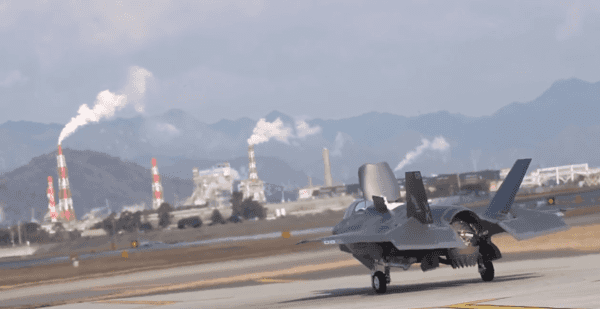The Marine Corps Air Station Iwakuni, or MCAS Iwakuni, is a U.S. Marine Corps air station located in Iwakuni, Japan. Home of Marine Aircraft Group 12 (MAG-12), 1st Marine Aircraft Wing (1st MAW), it is an integral part of the III Marine Expeditionary Force. The first operational F-35B bases in Marine Corps Air Station Yuma, Arizona, and Marine Corps Air Station Beaufort, South Carolina also have this aircraft stationed there.
Among the subordinate units that form the Marine Aircraft Group 12 is Marine Fighter Attack Squadron (VMFA-121), also known as the “Green Knights,” which is one of the first U.S. Marine Corps aircraft squadrons operating the F-35B Lightning II.

(Gung Ho Vids/YouTube)
Tail code “VK” and a radio call sign being “Combat,” Marine Fighter Attack Squadron (VMFA-121) has been training hard to master the new 5th generation F-35B JSF Lightning II, which has the particularity of a vertical landing as the highlight. In this video, VMFA-121 F-35B Lightning II fighter jets conduct flight training at home in the Marine Corps Air Station Iwakuni, Japan.
The F-35B the world’s first supersonic short take-off and vertical landing aircraft (STOVL). Its purpose is to function from unforgiving bases and a range of air-capable ships near front-line combat zones, however it can also take-off and land conventionally as well, according to F-35.com.
It is the “Rolls-Royce patented shaft driven LiftFan propulsion system and an engine that can pivot 90 degrees when in short takeoff/vertical landing mode that makes this aircraft what it is. It also uses the probe-and-drogue method of aerial refueling,” F-35.com explained.

(Gung Ho Vids/YouTube)
There is a rich history behind the F-35B, which was first the F-35A. In 2001, Lockheed Martin, Northrop Grumman and BAE Systems all partnered together and began production on the F-35. In February 2006, the first F-35A was completed in Fort Worth, Texas and was dubbed the “Lightning II. The F-35 “combines advanced stealth, integrated avionics, sensor fusion and superior logistics support — with the most powerful and comprehensive integrated sensor package of any fighter aircraft in history,” according to F-35.com.
It’s amazing to watch how a vertical landing is conducted and definitely not something you see every day. This is a complete game changer for pilots that have to make those landings quickly and precisely in places that may not otherwise be fit for one.
“What I will tell you, from the experience of going through STOVL training and then going out and executing the shortened take-off, or slow landing, and then the vertical landing, is that this is something the engineers at Lockheed Martin got 100 per cent correct.” Lt Col Gillette told Combat Aircraft Monthly.





